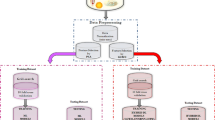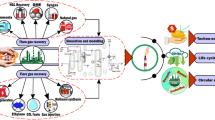Abstract
Although coal reserves are abundant in Pakistan, still share of gas and oil is about 65% in the energy mix. Pakistan, despite being a mineral-enriched country, is facing an alarming situation as its power generation is based on foreign exchange. The mineral sector of Pakistan is dominated by four principal minerals which are gas, oil, gypsum, and coal, while gypsum being a source of reclamation and poverty reduction. There is a strong need to analyze and forecast the production of these four principal minerals to cope up with emerging challenges. Data contains 114 observations from the period of July 2005 to December 2014, measured in terms of metric tonnes (MT). In parametric models, Box-Jenkins (B-J) methodology, a regression model with auto-regressive errors (ARAR), and Holt-Winter (HW) method are used to model. In nonparametric models, univariate singular spectrum analysis (SSA) and multivariate SSA (MSSA) modeling approach are applied. Data is split into train and test data in order to specify a suitable model for forecasting. Root Mean Square Error (RMSE), Mean Absolute Percentage Error, and Theil’s U statistic are utilized as the measure of accuracy. For gas and coal, HW model is a suitable model to forecast. For gypsum and oil, Auto-regressive Integrated Moving Average (Box Jenkins ARIMA) and MSSA provide more accurate predictions, respectively. The forecasts for gas and gypsum as compared to 2014 are expected to be approximately 11 % and 45 %, respectively, more in 2020. In 2020, the forecasts of oil are expected to be eight times more than in 2014. The production of coal in 2020 is expected to decrease 12 % than in 2014. There is a strong need to optimize the production of coal by providing incentives for exploration and mining. The stakeholders should make serious efforts to bring the production of coal at an optimum level such as by providing modern equipment and high incentives to promote coal mining and exploration.








Similar content being viewed by others
References
Ahmed S, Mahmood A, Hasan A, Sidhu GAS, Butt MFU (2016) A comparative review of china, India and Pakistan renewable energy sectors and sharing opportunities. Renew Sust Energ Rev 57:216–225
Ahmed F, Osama Daudpota, M, and Kashif M (2017). Oil price shocks and industry level production using vector autoregression: empirical evidence from Pakistan.
Aized T, Shahid M, Bhatti AA, Saleem M, Anandarajah G (2018) Energy security and renewable energy policy analysis of Pakistan. Renew Sust Energ Rev 84:155–169
Akhtar J, Yaqub MI, Iqbal J, Sheikh N, Saba T (2018) Way forward in meeting energy challenges in Pakistan. Int J Ambient Energy 39(8):904–908
Brockwell, P. J. and Davis, R. A. (2016). Introduction to time series and forecasting. springer.
Diebold FX, Kilian L (2000) Unit-root tests are useful for selecting forecasting models. J Bus Econ Stat 18(3):265–273
Dollar D, Kraay A (2002) Growth is good for the poor. J Econ Growth 7(3):195–225
Ejaz S, Aamir M, Khan MA, and Ashfaq B. (2018). Modeling and analysis of CPEC energy power projects using leap model. In 2018 International Conference on Computing, Mathematics and Engineering Technologies (iCoMET), pages 1–8. IEEE.
Groth A, Ghil M (2011) Multivariate singular spectrum analysis and the road to phase synchronization. Phys Rev E 84(3):036206
Hannah Ritchie MR (2018). Fossil fuels. Retrieved from: ’https://ourworldindata.org/fossilfuels’ [Online Resource]. Accessed 13 July 2019
Hassani H, Heravi S, Zhigljavsky A (2013) Forecasting UK industrial production with multivariate singular spectrum analysis. J Forecast 32(5):395–408
Holt CC (2004) Forecasting seasonals and trends by exponentially weighted moving averages. Int J Forecast 20(1):5–10
Hussain T (2003). Planning for sustainable development. Commission on Science and Technology for Sustainable Development in the South, page 72.
Hyndman RJ, Koehler AB (2006) Another look at measures of forecast accuracy. Int J Forecast 22(4):679–688
Kumar S, Shahbaz M (2012) Coal consumption and economic growth revisited: structural breaks, cointegration and causality tests for Pakistan. Energy Explor Exploit 30(3):499–521
McMahon G and Moreira S (2014). The contribution of the mining sector to socioeconomic and human development.
Mohr SH, Evans GM (2009) Forecasting coal production until 2100. Fuel 88(11):2059–2067
Mohr S, Evans G (2011) Long term forecasting of natural gas production. Energy Policy 39(9):5550–5560
Nawaz K, Lahiani A, Roubaud D (2019) Natural resources as blessings and finance growth nexus: a bootstrap ARDL approach in an emerging economy. Res Policy 60:277–287
Outlook AE et al (2010) Energy information administration. Dept Energy 92010(9):1–15
Parzen E (1982) ARARMA models for time series analysis and forecasting. J Forecast 1(1):67–82
Rehman A, Deyuan Z (2018) Pakistan’s energy scenario: a forecast of commercial energy consumption and supply from different sources through 2030. Energy Sustain Soc 8(1):26
Rehman SAU, Cai Y, Fazal R, Das Walasai G, Mirjat NH (2017a) An integrated modeling approach for forecasting long-term energy demand in Pakistan. Energies 10(11):1868
Rehman SAU, Cai Y, Mirjat NH, Walasai GD, Shah IA, Ali S (2017b) The future of sustainable energy production in Pakistan: a system dynamics-based approach for estimating hubbert peaks. Energies 10(11):1858
Ribeiro RCM, Marques GT, dos Santos PC (2019). Holt-Winters Forecasting for Brazilian Natural Gas Production. Int J Innov Educ and Res 7(6):119–129
Rutledge D (2011) Estimating long-term world coal production with logit and probit transforms. Int J Coal Geol 85(1):23–33
Satti SL, Hassan MS, Mahmood H, Shahbaz M (2014) Coal consumption: an alternate energy resource to fuel economic growth in Pakistan. Econ Model 36:282–287
Schindler J and Zittel W (2008). Crude oil–the supply outlook. Energy watch group.
Shahbaz M, Lean HH, Farooq A (2013) Natural gas consumption and economic growth in Pakistan. Renew Sust Energ Rev 18:87–94
Winters PR (1960) Forecasting sales by exponentially weighted moving averages. Manag Sci 6(3):324–342
Zami MS, Lee A (2010) Economic benefits of contemporary earth construction in low-cost urban housing–state-of-the-art review. J Build Apprais 5(3):259–271
Acknowledgements
The authors extend their appreciation to the Deanship of Scientific Research at the King Saud University for funding this work through research group no RG-1437-027.
Author information
Authors and Affiliations
Corresponding author
Ethics declarations
Conflict of interest
The authors declare that they have no competing interests.
Additional information
Responsible Editor: Domenico M. Doronzo
Rights and permissions
About this article
Cite this article
Saadat, S., Hussain, I. & Faisal, M. Modeling and forecasting of principal minerals production. Arab J Geosci 14, 797 (2021). https://doi.org/10.1007/s12517-021-07135-x
Received:
Accepted:
Published:
DOI: https://doi.org/10.1007/s12517-021-07135-x




